MSI GE40 Review: a Slim Gaming Notebook
by Jarred Walton on July 16, 2013 3:00 AM ESTMSI GE40 General Performance
The GE40 sort of straddles the line between being a gaming notebook and a standard laptop, but we’ll start off with a look at the general performance. Since the model we received has a 128GB SSD, PCMark 7 scores should only be compared with other SSD-equipped laptops to be meaningful. The remaining benchmarks on this page will look more at CPU and GPU performance. We also ran PCMark 8 (1.01—currently available for press use but not quite ready for the public), but we don’t have scores from most of the other notebooks. For the interested, the GE40 scored 4085 in the Home test (and 4108 in Home with the GTX 760M selected for OpenCL 1.1 tasks), 3855 in the Creative suite, 4873 in Work, and 4874 in Storage. As we run PCMark 8 on more notebooks, we’ll eventually include graphs, but for now the full scores are listed in Mobile Bench.
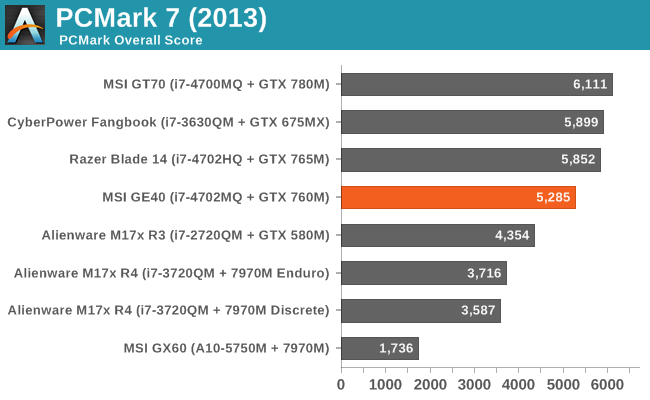

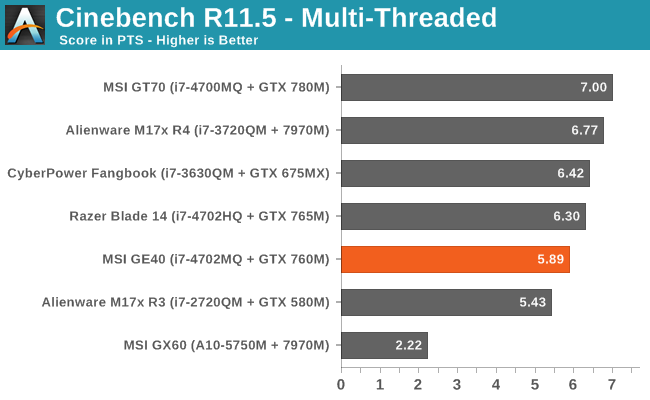
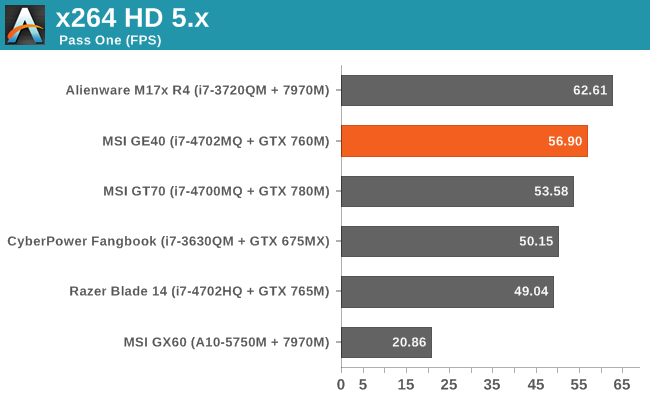
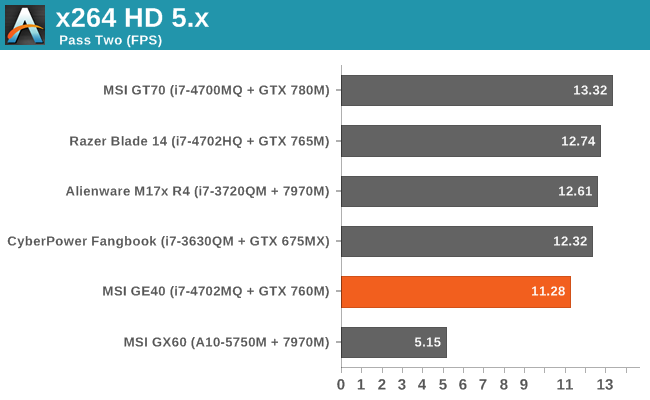
PCMark 7 places the Razer Blade 14 slightly ahead of the GE40, which is interesting as other than the SSD both are running similar hardware—the GPU shouldn’t matter much for PCMark 7. The Cinebench scores are also a bit odd, with the GE40 placing slightly ahead of the Razer Blade 14 in the single-threaded workload but quite a bit slower in the multi-threaded workload. X264 HD 5.0 continues that pattern with the GE40 beating the Razer by over 10% in the first pass, but then it falls behind by over 10% in the second pass. Given the newness of the HM87 chipset and Haswell processors, we are likely seeing minor variance caused by those factors. The GE40 also uses a single SO-DIMM, so potentially memory bandwidth plays a role as well, but outside of iGPU workloads we generally don’t see much scaling of performance with dual-channel memory. Whatever the case, all of the notebooks here (with the possible exception of the GX60) are “fast enough” for all of these tasks, so let’s move on.
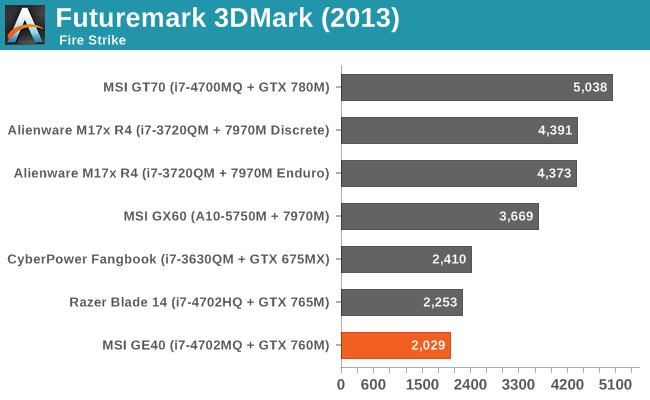
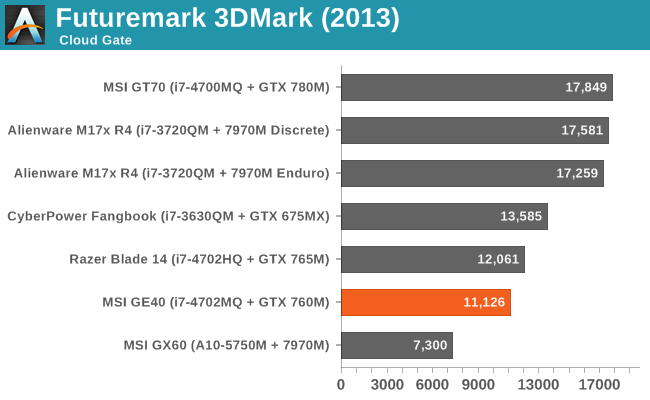


Looking at graphics performance, we start to get a hint of what the gaming benchmarks will tell us. In the mostly GPU-limited Fire Strike test, the GTX 760M places at the bottom of the charts, slightly behind the Razer Blade. Interestingly, while the GE40 is also at the bottom of the Ice Storm chart, it’s now basically tied with the GX60 and the Blade is 40% faster, which is more than the theoretical performance difference so we’re again seeing some discrepancies—possibly the single-channel RAM is to blame, or more likely the GE40 firmware isn’t fully optimized. Finally, in the Cloud Gate benchmark the CPU appears to be more of a factor and the GX60 falls well off the pace set by the Intel-equipped laptops. 3DMark11 on the other hand has yet another set of results, where this time the Sandy Bridge i7-2720QM and GTX 580M tie with the GE40. We don’t have results from the GTX 680M for the various 3DMark tests, though, so let’s see how things look there.










93 Comments
View All Comments
JarredWalton - Tuesday, July 16, 2013 - link
I would have reported throttling had it been evident. The CPU speed is dropping down from max turbo, but it's staying in the rated 2.2-3.2GHz throughout all the testing that I logged. In fact, for Metro Last Light, out of 500 data points over 1000 seconds, there was only one instance of 2.3GHz; everywhere else the CPU close were at least 2.4GHz and the average was 2.8GHz. I won't go so far as to say that the GE40 will never throttle while gaming, but it's definitely doing better than the Dell XPS 15 or Samsung Series 7 managed to do under similar testing.kogunniyi - Tuesday, July 16, 2013 - link
Will Anandtech review the Alienware 14 (and 17)?ufranco - Tuesday, July 16, 2013 - link
Just a side note , sorry to be off topic, wondering if you would be kind enough to do a review of windows 8.1 on a high dpi monitor to check how windows reacts.adityarjun - Tuesday, July 16, 2013 - link
I too would like to read about this. A para is written here http://www.anandtech.com/show/7145/asus-pq321q-fir... I am sure more will be said in the final review.adityarjun - Tuesday, July 16, 2013 - link
Just in case you do review the Alienware 17, please do note that it does throttle above 77C. The same goes for my current m17xr3. Despite reading almost every review on the net, i found out about this only after buying it. None of the reviews mentioned this.And this is not a throttle that can be ignored by someone like me from India where the ambient temperatures are quite high. I regularly hit 77C and it is a huge pain.
So in your reviews please mention this.
Also it would be great if in your gaming laptop reviews you would mention the gpu temperatures for different ambient temperatures (like doing the tests with AC on and then off).
And, as always, keep up the excellent reviews :)
kogunniyi - Tuesday, July 16, 2013 - link
You can fix the throttling by flashing a vBIOS or changing the temperature limit in Nvidia Inspector. Besides, the 780m should not reach 77C in the 17 after a good application of thermal paste.adityarjun - Tuesday, July 16, 2013 - link
No you cant.. Flashing vbios allows over volting. The 77C throttle remains.A repaste is not enough. My room temps are in the 35C range.
noeldillabough - Tuesday, July 16, 2013 - link
Eek, I cry when the room goes over 23Cadityarjun - Tuesday, July 16, 2013 - link
Haha.. Visit India during summers :)DanNeely - Tuesday, July 16, 2013 - link
Not going to happen unless I was only in the lowlands for long enough to board a second plane or a train heading for the mountains. Enough elevation can fix sub-tropical heat. :D